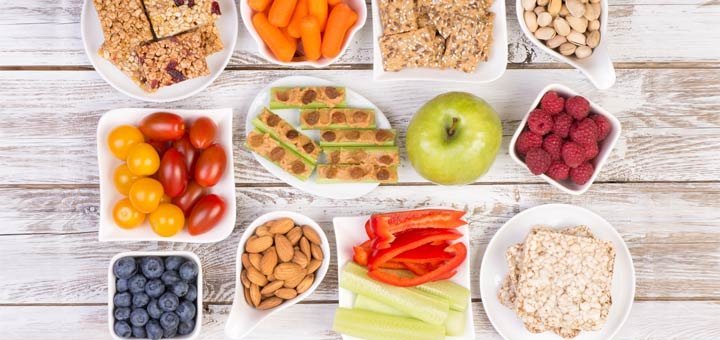Healthy Snacking and Shopping

We often hear that eating between meals will ruin your appetite but sometimes you just need a small bite of something to keep you going. Snacking can be a healthy way to balance out your meals, stay energized and get your needed nutrients. Reimagine your snacks as mini meals, that help you get through the day feeling energized. Read more to learn about planning and shopping for healthy go-to snack foods!
When do you need snacks?
Here are some circumstances when you might want to consider having a healthy snack:
- When you need an energy boost
- When your regular meal routine is interrupted or delayed
- Before and after exercise – snacking before a workout gives you energy and snacking after a workout can help to build muscle
- Anytime when meals are more than 5-6 hours apart. If you eat lunch at 12pm and eat dinner at 7pm, you could use a mid-day snack
- On long drives or road trips – planning snacks for long days away from home can help you avoid fast food
What Makes a Healthy Snack?
It can be easy to eat too many calories, especially if you snack straight from the packaging. Keep an eye out for calorie dense healthy snacks. Nuts are a very healthy snack, but if you’re not paying attention the calories can add up on a seemingly small portion. Read the nutrition label and try to portion out an appropriate serving size; making sure to put the container away before you start snacking. Factors to think about when snacking:
- The size of the snack should be a good amount; a balance between enough calories to satisfy you but still not too many. A simple way to think about it is to try to keep snacks to approximately 100-200 calories. Some 100-200 calorie snacks include:
- Yogurt
- 2 tsp. of peanut or other nut butter
- A serving of ANY fruit
- A cup of soup
- ¼ cup of nuts
- 1 piece of buttered toast
- 2 hard boiled eggs
- Once you find a few good go-to snacks, you can keep them on hand for when you need them. Read the nutrition facts label to see if it contains a good source of fiber, protein or whole grain and not too much fat, sugar or salt. Good rules of thumb for snacks are foods with <5 grams of fat, <20 grams of sugar and <250 mg of sodium. Easy snacks that are rich in fiber include: pears, avocados, applies, carrots, dark chocolate and popcorn.
- Pairing protein and carbohydrates will help the snack to keep you fullest for the longest. Examples include having apple and string cheese, whole wheat crackers with peanut butter, carrots and hummus, or yogurt and fresh fruit. Or, just pack a little extra small serving of whatever you are having for lunch and keep it for a snack later.
Other Tips to Keep in Mind
Although, the best way to avoid eating junk food or other unhealthy snacks is to not have these foods in your house. If you still want to satisfy your cravings, here are a few tips to make snacking at home easier:
- Store foods like cookies, chips, or ice cream where they are hard to see or reach. Put ice cream at the back of the freezer and chips on a high shelf. Move the healthier foods to the front.
- Don’t display candy. Replace the candy dish with a fruit bowl. Out of sight, out of mind.
- Avoid skipping meals. Skipping meals may seem like a good way to cut calories, but this will just make you so hungry later in the day that you are more likely to overeat.
Remember: It is okay to have an not-so-perfectly health snack once in a while, but to avoid sneaking unhealthy snacks or sweets, the key is balance and moderation.
Choose your snacks wisely
Choosing healthy snacks between meals can help keep hunger at bay and steer you away from vending machines that are typically full of unhealthy choices. The simplest way to control calorie intake from snacking is to have a well-stocked kitchen. Having nutritious snacks in your kitchen, or lunch bag is the first step to incorporating healthy snacks into your diet plan. Keep your house stocked with fresh fruits and vegetables. Also make sure to buy a variety so that you don't get bored with your selection. If you are not a regular grocery shopper, you could try a local delivery service, like Instacart. Order online, schedule a delivery time and have your groceries delivered. Most delivery services are relatively inexpensive and easy to manage online.
Whether shopping at your local grocery store or farm market or ordering online, we offer some tips for making healthy choices when shopping:
- The Nutrition Facts label is a great way to determine the healthfulness of your snacks. Pay attention to the portion size given on the label. Some portions sizes can be misleading as it is easy to eat more than this amount
- Plan ahead and make a list of what you need to buy
- Choose a time to shop when you are not in too much of a hurry and not too hungry.
- Don't forget that your local farmers market is a great place for finding healthy foods. Take time to research and visit farmers markets.
Recipe-Pumpkin apple protein bar
https://www.diabetesfoodhub.org/recipes/pumpkin-apple-protein-bars.html
References
https://healthlibrary.uhc.com/content/healthlibrary/uhc/hl/wellness/nutrition/stay_healthy/0086-3C-healthy-snacks-for-all.html
https://medlineplus.gov/ency/patientinstructions/000338.htm
https://www.mayoclinic.org/healthy-lifestyle/weight-loss/in-depth/healthy-diet/art-20046267
https://www.health.harvard.edu/staying-healthy/six-healthy-snacking-strategies
https://www.nia.nih.gov/health/choosing-healthy-meals-you-get-older
http://www.eatrightpro.org/~/media/eatright%20files/nationalnutritionmonth/handoutsandtipsheets/nutritiontipsheets/smart-snacking-for-adults-and-teens.ashx
https://edis.ifas.ufl.edu/pdffiles/FY/FY143400.pdf
https://www.eatright.org/health/weight-loss/tips-for-weight-loss/5-tips-to-curb-your-late-night-snacking
https://www.fda.gov/food/labelingnutrition/ucm274593.htm
https://www.nutrition.gov/topics/shopping-cooking-and-meal-planning
